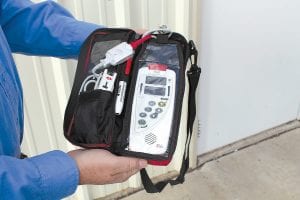Terry Spieker of the Hovland Fire Department presents a Masimo Rad57 Oximeter to Cook County Ambulance Director Steve DuChien. The medical device, which tests for the presence of carbon monoxide in a patient’s bloodstream, will be kept by the ambulance service to be used wherever needed throughout the county. The Hovland Fire Department found the funding to purchase the muchneeded monitor. Left: The small oximeter will be a big help to area emergency responders.

At the start of the 2012 heating season the Hovland Fire Department made good on its promise to purchase the medical equipment needed to determine if a patient is suffering the effects of carbon monoxide poisoning. After Lynn and Greg Barringer became extremely ill last winter because of continued exposure to carbon monoxide at their North Shore home, Hovland emergency responders wanted to make sure something like that did not happen again.
The Barringers began feeling ill in November 2011, but chalked the flu-like symptoms up to just that—the flu. However, the symptoms lingered for months so the home was investigated for mold. Those tests were found not to be an issue, but eventually the couple became so ill they were gasping for air.
Terry Spieker of the Hovland Fire Department visited and he inspected the carbon monoxide detectors. Pressing a button he found an alarming readout—the level of CO was 57 parts per million. A significant amount of CO, especially for as long as the Barringers had been exposed.
After shutting off the furnace and opening windows to air out the home, the levels dropped and the couple began to feel better. Although their health improved, a year later there are still some lingering physical effects. For that reason, the Barringers were happy to share their story, as a caution to others to make sure they have working CO detectors.
Unbeknownst to the Barringers, the CO detectors they had purchased recorded the CO level, but the units did not have an alarm feature.
The Barringers are also glad that the Hovland Fire Department pursued the purchase of special medical equipment to evaluate patients for possible CO poisoning. Reached by phone at their Florida residence, Lynn Barringer said, “If this kind of instrument had been available, doctors would have used it. We talked to doctors about the possibility of carbon monoxide poisoning, but since we had the monitors, it was ruled out. But with this quick and easy test, we would have known. A lot of tests could have been avoided.”
The Hovland Fire Department sought and received a grant from the North Shore Health Care Foundation for a portion of the cost of the equipment and hosted fundraisers for the remainder. This fall, Terry Spieker presented a Masimo Rad57 Oximeter to the Cook County Ambulance.
Accepting the device, Cook County Ambulance Director Steve DuChien said the ambulance service was very pleased to have the new oximeter. “Currently to test for CO poisoning, the person has to have arterial blood drawn and sent out for results,” he explained.
The device, which is not much bigger than an I-pad, will be kept on the ambulance, to be used anywhere in the county that it is needed. It can be quickly and easily used to test for the presence of CO in a person’s bloodstream by simply clipping a monitor on the patient’s fingertip.
DuChien said thanks to the Hovland Fire Department, the oximeter would be available to all fire and medical personnel all over the county. “We’ll be responsible for maintaining it, but we’ll deliver it to where it is needed or make arrangements for its use all over the county.”
Spieker said, “We don’t have a lot of resources in our rural county. The more partnerships we can make the better.”
The United States Environmental Protection Agency suggests buying a carbon monoxide detector as a backup— but not as a replacement for proper use and maintenance of your fuel-burning appliances.
The EPA adds, however, that it is important for you to know that the technology of CO detectors is still developing. They are not generally considered to be as reliable as the smoke detectors found in homes today. Some CO detectors have been laboratory-tested, and their performance varied.
A CO detector should sound an alarm when it detects an elevated level of CO in the household. Different detectors are designed with different options and features. Some are made to sound an alarm at persistent, low levels of CO while others will sound an alarm only at life-threatening levels. CO indicator cards and some devices are also intended to detect elevated levels of CO, but these devices are not equipped with an audible alarm and cannot wake room occupants at night, when most CO poisonings occur.
Underwriters’ Laboratory (UL) Listed CO detectors manufactured after October 1995 are required to have information on product packaging that clearly states the sensitivity level of the detector. Carefully read the product packaging of the CO detector you purchase, and understand what an alarm signal indicates.
A UL Listed CO detector will sound an alarm before dangerous levels of CO accumulate. This is important, because unlike a smoke detector, where you can easily confirm the cause of the alarm, CO is invisible and odorless, so it’s harder to tell if an alarm is false or a real emergency.



Loading Comments